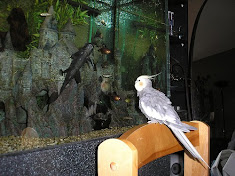 |
| Female Red Milk Snake by Jonathan Crowe |
As snakes are cold blooded, their body temperatures depend directly upon the temperature in their environment. Snakes have no self-cooling or heating systems. They simply move into and out of the heat. It's imperative, then, that you maintain a daytime temperature of between 80 and 85 degrees and a nighttime temperature between 65 and 75 degrees in your snake's tank. An adhesive thermometer and a heat lamp or cage heater that goes beneath the cage will help you accomplish these things. A snake that is even a few degrees below its optimal body temperature will often stop eating.
Speaking of eating, you should probably reconsider owning a snake unless you're 100% sure that you can handle feeding live or dead mammals to your pet. Smaller snakes will eat baby mice (called "pinkies") and medium to large snakes will eat either pinkies or adult mice. Larger snakes may require larger meals in the form of baby chicks or baby rabbits. Figuring out what your snake wants out of his meal may take some doing. Some snakes are terrified of live food and will only eat a mouse after its neck has been humanely broken (this kills the mouse instantly). Some snakes enjoy hunting and will not eat food that has already been killed, and some snakes don't care either way. While most snakes can live for weeks without food, it's best to feed an adult snake once a week or every ten days. Baby snakes should be fed more often to support their growing bodies. Check with a specific care guide for your snake to figure out how much food to offer your pet per feeding.
Once you've ascertained that your motivations for snake ownership are driven only by your love for these creatures, use your newfound patience to spend time searching for a variety of snake that fits your budget and your personality. Only buy a snake from a reputable source, and make sure you've either got an excellent book on pet snake care handy or an expert snake keeping acquaintance who can address any questions you may have and help you on the road to blissful snake ownership.
About The Author: Barry S. Mcgee is a pet enthusiast. His site at: http://www.squidoo.com/petcareonline provides advice and information on all aspects of pet care for all types of pets including dogs, cats, ferrets and others and makes it easier for pet owners to choose the best solution for their companion's care.
For answers to all your pet care questions, please visit: http://www.squidoo.com/petcareonline
Article Source: http://EzineArticles.com/?expert=Barry_Mcgee
http://EzineArticles.com/?Pet-Snake-Care&id=925144



0 comments:
Post a Comment